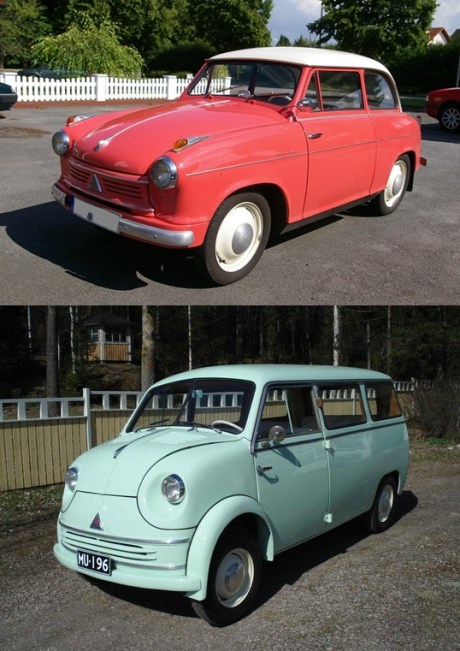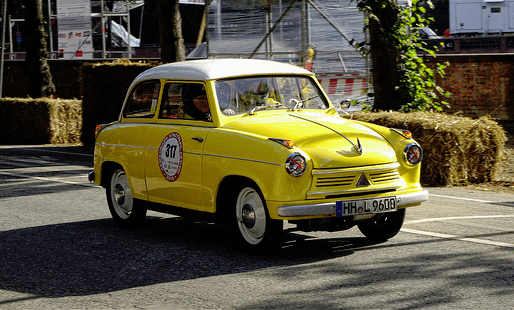(first posted 12/19/2011) The utter dominance of the Volkswagen made life very difficult for anyone else vaguely close to it in price and size, such as Lloyd. Although the Lloyds were substantially smaller and weaker, the VW cost only a modest amount more, thanks to the efficiencies of the vast Wolfsburg factory. I can’t find a ready price comparison in Germany, but in the US, a 1958 Lloyd with a 24 hp 600cc two-cylinder cost just $200 less than the much roomier and more powerful VW 1200. Yes, Americans were buying Lloyds back in the day, even if in small quantities.
But not for long.
I’ll answer that question after we do a bit of Lloyd history first. And since the Lloyd was only around for barely a decade, it will be a fairly short one. The father of the Lloyd was Carl Borgward, one of Germany’s more ambitious automotive entrepreneurs. It mostly started with this 1924 Blitzkarren (lightning cart), which given that it had 2.2 horsepower, the word Blitz was obviously being used tongue-in-cheek. Hopefully, anyway.
Later versions of it were a bit larger, but still three-wheeled. It was the just right thing for the Depression, and Borgward managed to make handsome profits on the Blitzkarren, which were used to build up his automotive holdings. We won’t go into the history of the Borgward brand here, because it’s a much richer story; more like sauerbraten. Another day.
After WWII, Borgward put up most of the capital to start Lloyd, its mission to build smaller cars below the Borgward family of cars. The first product, and the one that would define almost all Lloyds, was the LP 300, of 1950. Take a good look at its skin; does it look a bit like a padded vinyl top? That’s because it is.
Given the profound lack of steel in the immediate post-war era, the Lloyd’s body was made of plywood, covered in kunstleder (vinyl covered fabric, or its equivalent at the time). It was quickly dubbed the Leukoplastbomber, after a particular brand of medical adhesive tape that was readily employed to fix tears in the fabric skin. The Band Aid Bomber.
The other expression commonly used about it was “he who is not afraid of death drives a Lloyd”. Well, like in the USA, there was a big demand for affordable cars after the war, and the Lloyd got off to a surprisingly good start, despite its fabric body, which gave way to steel by about 1954. Motivating the Lloyd was a 10 hp, 300 cc two stroke twin.
What’s significant about the Lloyd’s power train is that it was one of the very first cars to have a transverse front engine with an inline transmission, as is now used on almost all modern FWD cars, Audis (and a few others) excepted.
The plump and soft LP 300 gave way to the sleek and steely LP 400 in 1953. Here’s one exhibiting its distinctive cornering style. Like so many German cars of the era, the Lloyd had swing axle rear suspension, even though it was front wheel drive.
The LP 400’s engine was bigger, and now had 13 hp, but its steel body was heavier, so the net result wasn’t much different. There’s another expression that the Lloyd earned: “stands at the foot of the mountain and howls”, referring to its gutless two-stroke. The inline transmission is clearly visible here.
Lloyd listened, and unlike DKW, ditched the two-stroke for 1955. Now with an OHC four-stroke air-cooled twin up front with all of 600 cc, the LP 600 now had 19 hp.
Don’t laugh (too hard), it was at least as fast as the contemporary VW. And folks bought Lloyds, as evidenced by the fact that in 1955, they were the number three selling brand in Germany, after VW and Opel.
My godfather (on left) was one of them, and he had a yellow one with a sunroof like the one above. Being well over six feet, he kept the sunroof open as much as possible. He came to visit, and we all (or most of us anyway) piled in for an outing up in the mountains. Somehow the LP 600 made it, as evidenced by this picture, its four-stroke twin bleating more than howling. And as much as I liked the ride, listening to my father (right) blab on about philosophy, literature or some such thing was a bit of a bore. Why couldn’t they talk about cars?
The Lloyd benefited from regular improvements, and by 1957, the deluxe version was now called Alexander, like this cabrio version.
The Alexander even got a hi-po version, the TS, with a whopping 25 hp. A veritable pocket-rocket. Maybe that’s what my godfather had; I can’t remember that detail. The next time I saw him in 1969, he was driving an Audi Super 90. The years between 1959 and 1969 were a time of very rapid income growth in Austria.
As surprising as it may seem, Lloyds sold reasonably well in the US, during the great import boom from 1955 through 1959. This brochure has the stamp from a Milwaukee dealer on it. But then Milwaukee was populated by Germans…
The US-bound Lloyds were mostly top-line Alexanders, with 24 and 29 (gross) hp ratings, and a 70 mph top speed. Prices started at $1295 ($9600 adjusted), and the cars weighed in at about 1200 lbs. Sorry if I’m skipping around, but I’m saving the Iowa Lloyd story for the end. Hang on.
From the picture at the top of the article, Lloyd obviously made a family of commercial vehicles based on the LP series. It’s hard to find pictures of the pickup version, but the transporter and van appear to have been quite common enough.
The van was even made in short (above),
and extended-length versions. The Lloyd Grand Caravan LT600. No T&C version,
unless we can call this early version with the vinyl-fabric body a “woody”. Just like the later American woodie wagons, just no steel under the vinyl.
Room for six, with one hundred cc of engine displacement for each passenger (actually 66.6 for the 400cc LT 500). How’s that for efficient, compared to the 1850cc of engine displacement a fully loaded Mark IV afforded each of its four occupants?
We’re getting to the end of the sad Lloyd-Borgward story. Carl Borgward was a superb engineer, but his ambitions started to run ahead of his cash flow in the late fifties. Not only was he trying to compete against Mercedes in the mid-upper price levels, but his very ambitious replacement for the LP600/Alexander, the Arabella (above) may have been the final coffin nail in his empire.
As so many uncompromising technically advanced designs, it had a boxer four, now water cooled, of some 900 cc capacity (almost a full liter) and developing a rather lofty 38 to 45 hp. But development expenses hit hard, precisely when US sales of the Alexander sputtered out, in 1960. Income from US imports was a critical factor in Borgward’s finances, and the crash of the import boom directly contributed to the bankruptcy of Borgward.
I wrote about it here, but after we arrived in Iowa City in 1960, I had never expected to see another Lloyd, unaware that any had been imported. Then the hot-rodders across the street picked up a poor old clapped-out Lloyd after their ’51 Ford project car expired. They spent a whole summer driving around in it, which was pretty ridiculous: three or four big beefy guys cruising in a Lloyd without a muffler. Beat walking, I guess.
Anyway, they tried driving it down to Burlington, and it expired somewhere near there. Some years later, I drove past a junkyard just outside Burlington, and the Lloyd was now an ornament for their sign, sitting high on top of a pole. And according to a commentator, it was still there as of a few years ago.
And recently, CC reader/contributor Tom Klockau sent me this picture of this Lloyd Alexander wagon. I know Tom lives near Iowa, so I’m assuming this one is from there too. And so my Lloyd story has come full circle. Or maybe just to an end.









































In 1969 I found a Lloyd in wrecking yard at Ft Worth,Tx, bought it for $20.00. Engine was single cylinder and drove left front wheel. Body was like VW bolted to pan. Removed body,cut pan into taking out front seats and movind rear seat for driving. Did not have much power or speed but it was neat little buggy.
I have a 1960 Lloyd 600 Panel Van. It’s been in the family since 1973. The registration had shown it was on Catalina Island. In the start of Year 1990 I did my best to refurbish it. My completion was at the end of 1993. Oops, forgot to mention the top was cut off when I received it. We have had a lot of fun drives and still drive it today.
Along the way I found another 1960 Lloyd Panel Van. The front seats and the brake lights are not original. All else is. I have not refurbished this one.
( Also for sale ). I have also found many engine parts and drive parts.
Not sure who may read this, but If interested in more info please let Mark know.